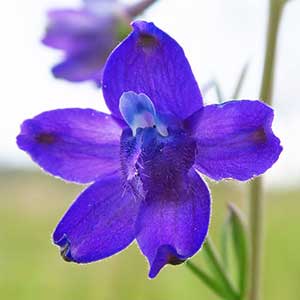Delphinium nuttallii subsp. nuttallii
(synonym of Delphinium oreganum)
Delphinium parryi
Willamette Valley larkspur
Parry's larkspur, San Bernardino larkspur
40-70 cm.
(10-)40-80(-110) cm;
base reddish, puberulent.
blade pentagonal, 1-7 × 2-10 cm, ± puberulent; ultimate lobes 3-27, width 1-20 mm (basal), 0.5-5 mm (cauline).
(2-)8-24(-48)-flowered, cylindric;
pedicel ± spreading, (0.5-)1-3(-6.8) cm, usually puberulent;
bracteoles 2-7(-16) mm from flowers, green to blue, lance-linear, 2-6(-10) mm, puberulent.
sepals blue or bluish purple, spurs 10-13 mm;
lower petal blades 4.5-6.5 mm.
sepals dark blue to bluish purple, puberulent, lateral sepals spreading or reflexed, (7-)10-20(-25) × 4-9 mm, spurs straight, ascending 0-30° above horizontal, 9-17(-21) mm;
lower petal blades slightly elevated, ± exposing stamens, 3-10 mm, clefts 2-6 mm;
hairs mostly near base of cleft, centered or on inner lobes, white.
10-19 mm, 2.8-4 times longer than wide, puberulent or glabrous.
seed coat cells ± brick-shaped, cell margins undulate, surfaces ± roughened.
= 16.
Delphinium nuttallii subsp. nuttallii
Delphinium parryi
Subspecies 5 (5 in the flora).
A number of local phases are found in Delphinium parryi. Five of these appear consistently distinct and are recognized here. Other phases may be locally distinct but grade into other nearby phases. Delphinium parryi hybridizes with D. cardinale (D. ×inflexum Davidson).
The Kawaiisu used the ground root of Delphinium parryi medicinally as a salve for swollen limbs (D. E. Moerman 1986, no subspecies specified).
(Discussion copyrighted by Flora of North America; reprinted with permission.)
1. Basal leaves usually absent at anthesis. | → 2 |
1. Basal leaves usually present at anthesis. | → 3 |
2. Lateral sepals 16–25 mm. | subsp. blochmaniae |
2. Lateral sepals 9–15 mm. | subsp. parryi |
3. Lateral sepals 7–11 mm; above 700 m elevation. | subsp. purpureum |
3. Lateral sepals (9–)12–20 mm; below 700 m elevation. | → 4 |
4. Sepals usually reflexed. | subsp. eastwoodiae |
4. Sepals usually spreading. | subsp. maritimum |


